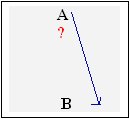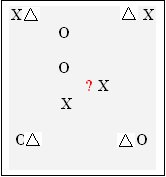COLLECTIVE SPORTS
UNIT: HOCKEY
LESSON: 1
Contents:
DRIBBLE, PUSH AND RECEIVE
3 v 1 AND4 v 4 GAMES, MOVING INTO SPACE TO SUPPORT
APPARATUS: Mini sticks, balls, cones, bands.
ORGANISATION
CONTENT
TEACHING POINTS
Number of players: 8, divided into two teams of 4, attackers (A) and defenders (D).

The area has to be divided into four.
WARM UP; familiarisation with the sticks
1- Four Square
There are two teams of 4. One team is the attackers and the other is the defenders. All of them with a stick. Each side has one player in each section, so in each section there is a defender and an attacker.
Attackers must dribble, dodge and pass ball from section to section, without defenders intercepting pass.
Defenders are not allowed to tackle but can try to block the pass. If defenders block the pass, they pass the ball to another attacker in another section to continue game.
Score 1 point for each successful pass between attackers. Score 2 points if pass goes through any gate.
Attackers play for 90 seconds then change over.
Changes to the game:
- Match younger players with similar age players.
- Younger players score double points for getting ball through gates.
Easier: slightly enlarge playing area so attackers have more room to move.
Harder: Slightly reduce playing area or put in gates through which pass must go.
Spaced out.
MAIN PART:
skills; dribble
2- Dribble 1:
Children are spaced out and have a stick each. They have to hold the stick with their hands a part grip – left hand at top, right half way down- and run in and out controlling the ball. When the teacher blows the whistle, pupils have to stop the ball, place the stick flat side down and jump over it 10 times. Children should bend forward and bend knees to dribble the ball in front with their head up. Repeat several times.
In partners, one dribbling, one static.
3- Dribble 2:
Pupils now work in partners (A, B). A has to dribble and B has to be static. Therefore, half of the class is dribbling and the other half is static. Dribblers have to dribble the ball around the half of the class who are spread out. Then, they change roles.
In partners, space out.
4- Dribble 3:
Pupils still work in partners (A, B), spaced out. In a standing position, they have to pull the ball from the right to the left foot, then back, reversing the stick. The left hand controls the turn while the right hand relaxes to let the stick turn in order to use the flat side of the stick.
In pairs, 5m apart.
Add targets to increase the challenge.
Alter distance if necessary
SKILLS; push and dribble
5- Push and stop:
Children work in partners and have to push and stop the ball. First, A pushes the ball and B stops it. Then B pushes the ball and A stops it. How many “push and stop” can they do in 30 seconds?
Aspects to take into account:
Body side-on to partner.
Right hand controls direction and power.
Follow through with stick – no higher than waist height.
Stop-stick upright, left hand extended forward slightly to control stop.
In a grid 5m x 5m. In partners

6- Push past your partner :
Children work in partners and have to push the ball past the partner. Therefore, A tries to push the ball past his/her partner (B), while B tries to avoid it. If A scores, then B restarts the game trying to score a goal to his/her partner. The first one to score 4 goals wins.
Aspects to take into account:
Look at the partner, bend knees for a strong push away from the partner.
? Is your partner sideways on?
? Does your partner follow-through?
7- 3 v 1
There are three attackers and one defender. If attackers can manage to pass the ball between them 3 consecutives times they get 1 point. Tackling is not allowed. After 5 points, change defender.
Attackers are spaced out, working in a triangle and supporting each other. They have to try hard not make it easy to be marked. They move and can pass the ball in different directions, they can pass backwards too. They should draw the defenders towards them before passing the ball.
The defender has to put pressure on the passer and move in.
In a grid 10m x 10m.

GAME;
8- 4 v 4
Children are divided in groups of 4 and one group of 4 plays against another group of 4. Two players in each team are in the cones to receive a pass for 1 point. So, in a team 2 players are in the cones and the others 2 players try to pass them the ball. They have to pass the ball a minimum of 2 passes before passing to the ones in the cones. The players support each other, trying to keep possessions with safe passes in different directions. In defence, they have to mark one opponent but be ready to run back to support your team mate.
RULES:
• Pass back to start and restart the game.
• Shoot from anywhere – push only.
• No lifting or playing the ball in the air.
• No tackling sticks, holding, pushing or kicking.
• A free pass for a foul – other players 3m away.
• The defender passes out if the ball goes off the back line.
The teacher has to decide whether the pupils have to pass or dribble in attack.
- When must you mark closely as a defender? When you are near the goal
- Is your teammate finding space to receive the ball?
- Is he/she looking for the free goal?